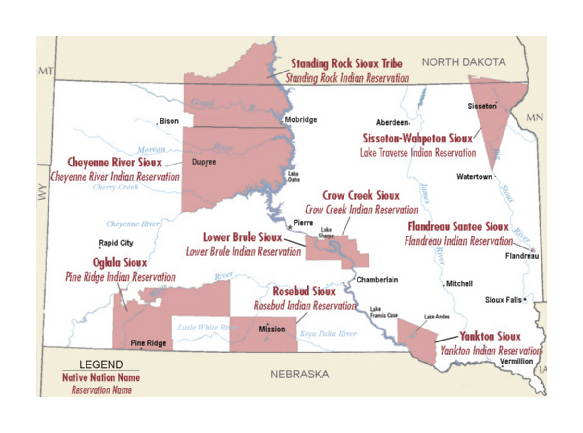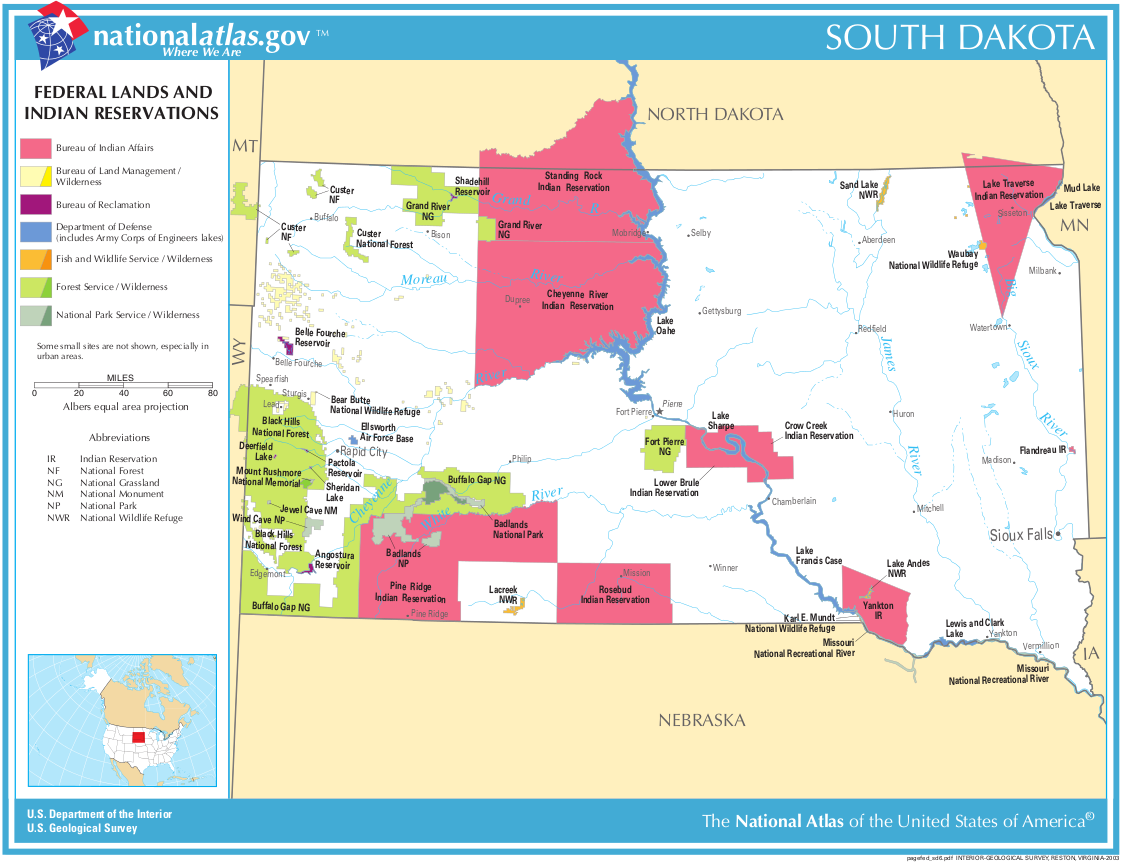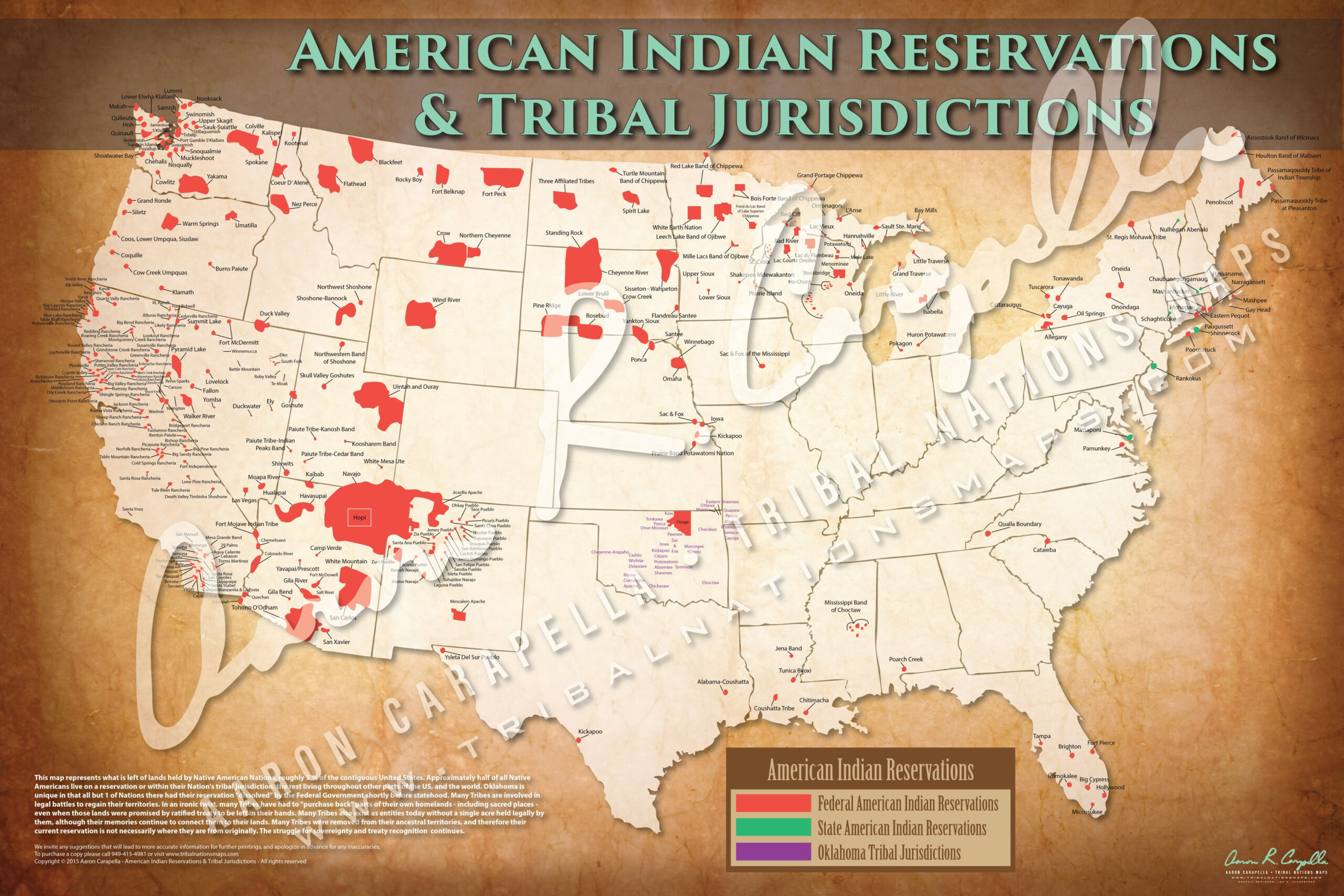South Dakota’s Tribal Tapestry: A Map of Resilience and Tradition
South Dakota’s Tribal Tapestry: A Map of Resilience and Tradition

South Dakota, a state known for its sprawling prairies, rugged Badlands, and iconic Mount Rushmore, is also home to a vibrant and diverse Native American community. Across its vast landscapes, nine federally recognized tribes have called this land home for centuries, their history and culture woven into the very fabric of the state. Understanding the geography of these tribes is essential to appreciating the rich tapestry of South Dakota’s heritage. Let’s embark on a journey through the state, exploring the locations and stories of its nine sovereign nations.
A Map of Nine Nations:
Related Articles: South Dakota’s Tribal Tapestry: A Map of Resilience and Tradition
- Unveiling the Intriguing Absence: Why Oklahoma Stands Unique
- Unveil the Enchanting Indian Reservations of New Mexico
- Unveiling Healthcare Truths: Indian Reservations and Hospitals Unveiled
- Unlock the Enchanting Tapestry of Oklahoma's Native Heritage
- Unveiling the Tapestry of Central Texas: Discover the Native Tribes That Shaped Its Destiny
To truly grasp the significance of South Dakota’s tribal lands, it’s crucial to visualize them. Imagine a map, dotted with vibrant hues, each color representing a unique tribe and their ancestral homelands. Let’s dive into each of these vibrant spots, starting with the Cheyenne River Sioux Tribe:
1. Cheyenne River Sioux Tribe:
Nestled in the northwest corner of South Dakota, the Cheyenne River Sioux Tribe occupies a vast territory of over 2.2 million acres. This sprawling reservation, encompassing the heart of the state’s prairie landscape, is a testament to the tribe’s resilience and enduring spirit. The Cheyenne River Sioux have a rich history, their ancestors having traversed these lands for generations. Today, the tribe actively works to preserve their culture and traditions, ensuring their legacy continues to thrive.
2. Standing Rock Sioux Tribe:
The Standing Rock Sioux Tribe, located in the southwestern corner of the state, straddles the Missouri River, a vital lifeline for their people. Known for its stunning natural beauty, the reservation is home to a diverse landscape, from rolling hills to the rugged Badlands. The Standing Rock Sioux Tribe has been at the forefront of environmental activism, fiercely protecting their sacred lands and water resources. Their fight for clean water and environmental justice serves as a powerful example of their commitment to preserving their home for future generations.
3. Oglala Lakota County:
The Oglala Lakota County, also known as the Pine Ridge Reservation, occupies a vast swath of land in southwestern South Dakota. The reservation, one of the largest in the United States, is home to the iconic Badlands National Park, a testament to the region’s rugged beauty. The Oglala Lakota people have a long and storied history, their resilience and strength evident in their ability to maintain their cultural identity amidst numerous challenges.
4. Crow Creek Sioux Tribe:

Located in central South Dakota, the Crow Creek Sioux Tribe occupies a relatively smaller reservation, but their cultural significance is immense. The tribe’s history is deeply intertwined with the Missouri River, which serves as a vital source of sustenance and cultural significance. The Crow Creek Sioux Tribe is known for its vibrant arts and crafts, their beadwork and pottery reflecting their rich artistic heritage.
5. Yankton Sioux Tribe:
The Yankton Sioux Tribe, situated in the southeastern corner of South Dakota, occupies a reservation that encompasses a blend of prairie and riverine landscapes. The tribe has a long history of resilience, having survived numerous challenges and maintaining their cultural identity throughout. The Yankton Sioux Tribe is known for its strong community spirit and commitment to preserving their traditions.
6. Lower Brule Sioux Tribe:
The Lower Brule Sioux Tribe, located in central South Dakota, occupies a reservation along the Missouri River. The tribe’s history is deeply rooted in the river, which has served as a vital source of food, transportation, and spiritual connection. The Lower Brule Sioux Tribe is known for its strong community bonds and commitment to preserving their cultural heritage.

7. Sisseton Wahpeton Oyate:
The Sisseton Wahpeton Oyate, located in the northeastern corner of South Dakota, occupies a reservation that encompasses a mix of prairie, lake, and woodland landscapes. The tribe’s name, "Wahpeton," translates to "people of the prairie," reflecting their deep connection to the land. The Sisseton Wahpeton Oyate is known for its vibrant cultural traditions, including powwows, storytelling, and traditional arts.
8. Flandreau Santee Sioux Tribe:
The Flandreau Santee Sioux Tribe, located in the southeastern corner of South Dakota, occupies a reservation that encompasses a blend of prairie and riverine landscapes. The tribe’s name, "Santee," translates to "people of the river," reflecting their strong connection to the Missouri River. The Flandreau Santee Sioux Tribe is known for its commitment to education and economic development, striving to create a brighter future for their community.
9. Rosebud Sioux Tribe:

The Rosebud Sioux Tribe, located in the southwestern corner of South Dakota, occupies a reservation that encompasses a vast expanse of prairie and Badlands. The tribe’s name, "Rosebud," reflects the abundance of wild roses that once flourished in the region. The Rosebud Sioux Tribe is known for its rich cultural traditions, including powwows, storytelling, and traditional arts.
Beyond the Map: A Deeper Dive into South Dakota’s Tribal Heritage
While this map provides a visual representation of the state’s tribal lands, it’s only the beginning of understanding the rich tapestry of South Dakota’s Native American heritage. Each tribe has its unique history, language, traditions, and stories, woven together to create a vibrant cultural mosaic.
The Impact of History:
The story of South Dakota’s Native American tribes is inextricably linked to the history of the United States. From the forced relocation of tribes during the 19th century to the ongoing struggle for self-determination, these communities have endured countless challenges. The history of treaty violations, assimilation policies, and economic hardship has left a lasting impact on the lives of Native Americans in South Dakota.
The Power of Resilience:
Despite the hardships they have faced, South Dakota’s tribes have demonstrated remarkable resilience. They have maintained their cultural identities, preserved their languages, and continued to thrive in the face of adversity. Their traditions, stories, and spiritual practices continue to inspire and guide future generations.
A Commitment to Self-Determination:
Today, South Dakota’s tribes are actively working to achieve self-determination and economic independence. They are developing their own businesses, creating jobs, and investing in their communities. Their commitment to education, health care, and cultural preservation is a testament to their strength and determination.
Cultural Preservation and Revitalization:
South Dakota’s tribes are actively engaged in preserving and revitalizing their cultures. From language immersion programs to powwows and traditional arts festivals, they are ensuring that their traditions continue to thrive for future generations. They are also sharing their knowledge and stories with the broader community, fostering understanding and appreciation for their rich heritage.
Tourism and Cultural Exchange:
South Dakota’s tribal lands offer a unique opportunity for visitors to experience Native American culture firsthand. From museums and cultural centers to powwows and traditional arts demonstrations, there are numerous opportunities to learn about the state’s rich heritage. Tourism can be a powerful force for economic development and cultural exchange, fostering understanding and appreciation between Native American communities and the wider world.
A Look Ahead:
The future of South Dakota’s tribes is bright. They are poised to continue their journey of self-determination, economic development, and cultural preservation. Their resilience, strength, and cultural richness will continue to inspire and shape the state’s future.
FAQs about Indian Reservations in South Dakota:
1. What is the difference between a reservation and a tribe?
A reservation is a designated area of land set aside by the federal government for a specific Native American tribe. A tribe is a sovereign nation with its own government, laws, and culture.
2. How many reservations are there in South Dakota?
There are nine federally recognized tribes in South Dakota, each with its own reservation.
3. Can I visit a reservation?
Many reservations welcome visitors, but it’s important to respect tribal customs and traditions. It’s always a good idea to contact the tribal government or tourism office for information and guidance.
4. What are some of the cultural attractions on reservations?
Reservations offer a wide range of cultural attractions, including museums, cultural centers, powwows, traditional arts demonstrations, and storytelling events.
5. How can I support Native American communities in South Dakota?
There are many ways to support Native American communities in South Dakota, such as visiting tribal businesses, purchasing Native American art and crafts, and supporting organizations that work to preserve their culture and heritage.
6. How can I learn more about the history of Native Americans in South Dakota?
There are many resources available to learn more about the history of Native Americans in South Dakota, including museums, libraries, websites, and books.
7. How can I get involved in efforts to support Native American rights?
There are many organizations working to support Native American rights, such as the Native American Rights Fund, the American Indian Movement, and the National Congress of American Indians. You can support their work by volunteering, donating, or advocating for their cause.
In Conclusion:
South Dakota’s tribal lands are not just geographic locations; they are living testaments to the resilience, strength, and enduring spirit of the state’s Native American communities. By understanding the history, culture, and geography of these tribes, we gain a deeper appreciation for the rich tapestry of South Dakota’s heritage. Let’s continue to learn from these vibrant communities, support their efforts to achieve self-determination, and celebrate their contributions to the state’s cultural landscape.

Closure
Thus, we hope this article has provided valuable insights into South Dakota’s Tribal Tapestry: A Map of Resilience and Tradition. We appreciate your attention to our article. See you in our next article!


